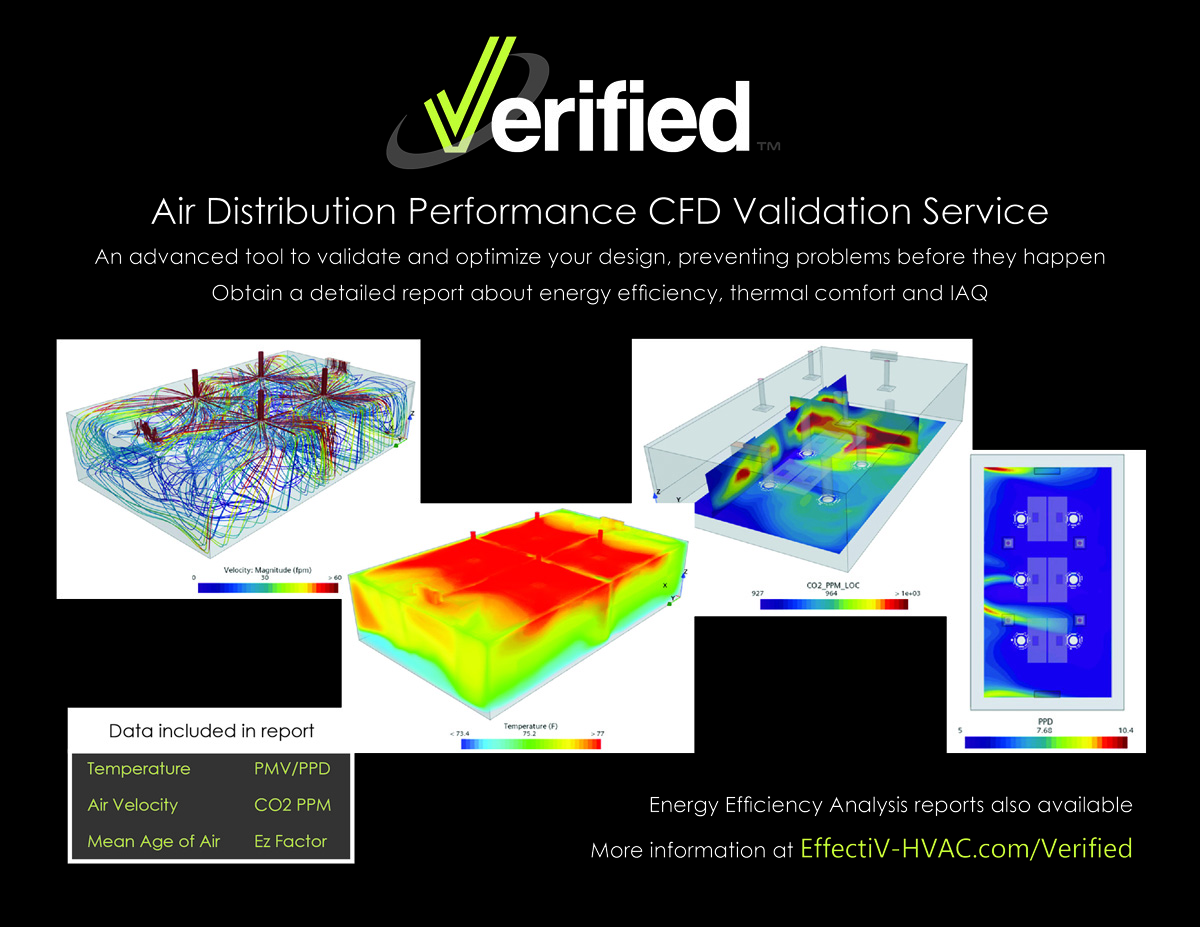Verified
Air Distribution Performance CFD Validation Service by EffectiV
Verified is a computer fluid dynamics (CFD) service offered by EffectiV to simulate the airflow in one room.
The service delivers reports with a precise and realistic representation of the airflow, thermal comfort and indoor air quality in the room. The CFD simulation conditions are set to match the actual operating conditions of the room, including room size, shape, location, temperature, humidity and occupancy levels.
The CFD simulations are made in accordance with the method proposed in ASHRAE Standard 62.1 – 2022 – Ventilation and Acceptable Indoor Air Quality.
To prepare for the simulation, we recreate your room in a 3D environment and set the positioning of diffusers and returns, windows, occupants, and objects in the room.
Once the room is ready, you provide us with the operating conditions that you would like to simulate, for instance a VAV system in heating and cooling, the outdoor temperatures, supply temperatures and set points. It is possible to test multiple operating conditions, however each operating condition requires a new CFD simulation.
The reports provided include visual representations of the air velocity, air temperature, mean age of air, thermal comfort (PMV/PPD), CO2 particles per million (CO2 PPM) and Ez Factor everywhere in the room, with views from different angles.
Click here to view an example of CFD Simulation Report
Energy Efficiency Analysis
For projects targeting LEED, WELL or other energy efficiency certifications, we also offer a complete energy efficiency analysis of an air distribution design in one room.
The analysis focuses on quantifying the energy efficiency performance of the proposed design, as well as its impact on indoor air quality and thermal comfort for occupants. The analysis utilizes the normalized design approach outlined in ASHRAE Standard 105-2021 to establish a benchmark for comparison and identify areas for improvement.
For this service, we need to run two simulations with the same operating conditions, one for your design using high-performance diffusers, and another one for the normalized design using commonly used diffusers.
In the report, we compare your design with the normalized design to identify potential energy savings, while also analyzing the impact on thermal comfort and IAQ.
The impact on energy consumption is quantified using two metrics:
- Energy Consumption for Thermal Comfort
For VAV systems, we compare the volume of air needed to reach the desired room temperature in heating and cooling. For systems with a fixed air volume, we can vary the temperature instead. In both cases we compare the air volume required by your design versus the normalized design.
- Energy Consumption for IAQ
Indoor air quality is another important aspect of evaluating the performance of an air distribution design. The ASHRAE Standard 62.1 – 2022 – Ventilation and Acceptable Indoor Air Quality suggests using the Ez Factor value to evaluate the air distribution effectiveness in a room. The Ez Factor represents the Zone Air Distribution Effectiveness, or in other words, the air mixing effectiveness in the room. Inefficient room air mixing will result in a lower Ez value, which will increase the minimum ventilation rates required to ensure acceptable indoor air quality, which will increase energy consumption.
Click here to view an example of and Energy Efficiency Report
Diffusers and air mixing have a significant impact on energy efficiency, indoor air quality and thermal comfort like no other component of the HVAC system. With Verified, we can now quantify that impact and validate designs before the system is installed.

